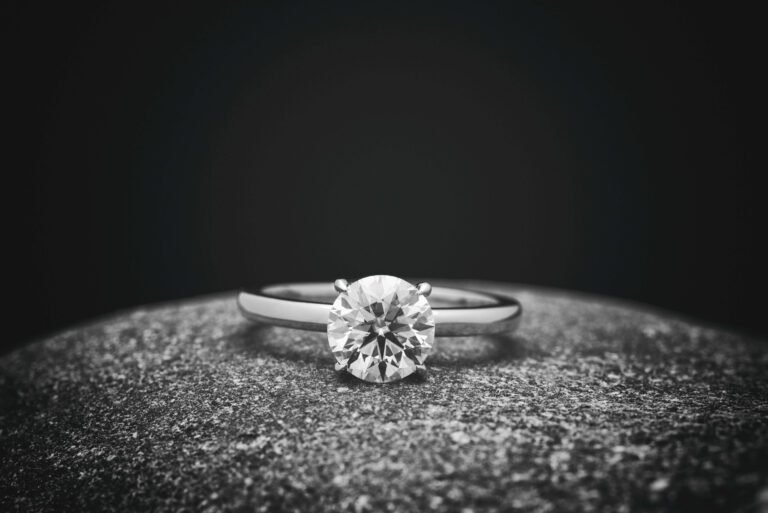Platinum and its Patina

Platinum is one of the most prized metals in fine jewelry. It has a bright, natural white tone, a high degree of durability, and is known for being rare and valuable.
While platinum may look like white gold, it does differ in two main ways. Firstly, it doesn’t require rhodium plating to achieve its bright, white shine. Secondly, platinum naturally develops what’s known as a patina—a soft, matte-like sheen that forms with regular wear. Rather than being a flaw, this finish is valued by many as part of platinum’s character, reflecting the life and story of the piece.
In this article, we discuss what platinum patina is, how it develops, what it looks like, and what your options are, whether you choose to preserve it or prefer to restore a polished shine.
What Is Platinum Patina and What Does It Look Like?
Instead of maintaining the bright, mirror-like polish it has when new, platinum gradually develops a satin-like finish with wear. This finish is the patina, and comes about through the countless microscopic marks that form on the jewelry’s surface that comes with daily wear.
Visually speaking, the patina does bring a more muted look with a loss of luster. That said, the look of the patina gives a duller appearance, with the metal looking slightly darker or grayer than its freshly polished state.
For some, the subtle look of a patina adds a sense of history. For others who prefer high-shine brilliance, the patina may feel less appealing.
It’s also important to understand that patina is not the same as tarnish.
Tarnish is a chemical reaction that causes metals like silver or lower-karat gold to discolor when exposed to oxygen, sulfur, or moisture. Platinum, on the other hand, is highly resistant to corrosion and will never tarnish. Its patina is purely a physical change to the surface texture, not a sign of damage or degradation.
What makes platinum unique is that this change doesn’t compromise the metal’s strength.
Platinum doesn’t wear away like gold or silver—its density means the metal simply shifts rather than erodes. Where gold rings may become thinner with long-term wear, platinum retains its form.
Whether you like the patina and opt to keep it or restore the original polish, platinum remains a solid choice for your jewelry piece if durability is important.
How Platinum Patina Develops
Every day wear is the prime driver of platinum’s patina. Activities like gripping objects, brushing against surfaces, or even resting your hand on a desk create microscopic marks on the metal. These gradually build into a soft, grayish sheen that scatters light more gently than a polished surface.
With this in mind, the timeline for patina development varies from person to person and from piece to piece.
For example, a platinum wedding band that’s worn daily may begin to develop a patina within the first year, while earrings or pendants (which are pieces that receive less contact) may take much longer. One thing to take note: platinum doesn’t lose volume as it’s worn. Whereas other metals may have microscopic parts of it dislodged and become thinner over time, platinum just has its matter “shifted” as it’s worn, without having any loss of volume.
Preferences of a Patina
Whether the look of the patina is for you or not depends solely on personal taste. Some prefer platinum solely for the patina and the antique-like glow it creates, which pairs beautifully with diamonds and gemstones.
Others feel the matte look takes away from platinum’s brilliance.
Below, we’ll outline both approaches—how to preserve the patina if you love it, and how to remove it if you’d rather keep your platinum bright.
Preserving the Patina
If you like the natural, softened look of patina, you can keep it consistent and attractive with a few simple steps:
- Gentle Cleaning: Wash your platinum piece with organic soap and warm water. Use a soft cloth to remove oils and buildup without adding extra shine.
- Avoid Over-Polishing: Skip abrasive cloths or strong cleaners that might reduce or buff away the patina’s texture.
- Regular Wear: Continue wearing your piece daily—patina develops and blends naturally with use.
Patina Removal
Remember, patina is not a chemical process, but rather a physical change of the surface of the metal.
With that said, if you prefer that new reflective finish, the patina can be polished and buffed away.
- Professional Polishing & Cleaning: A jeweler can buff platinum back to a bright, mirror-like surface in minutes. Since platinum doesn’t lose metal during polishing, this can be done repeatedly without harming the piece.
- Home Maintenance: Light cleaning with mild soap, warm water, and a soft cloth can help maintain shine between professional polishes.
Conclusion
Choosing whether to let platinum’s patina develop or polish it away is entirely up to you.
If you like the sense of history and the antique look that the patina brings, preserving it is an option. If you like the reflective shine, polishing can always be done.
At the end of the day, the important thing to remember is that platinum’s core qualities remain the same – it’s an extremely durable metal that’s rare and holds its value.
At Kim Quang Jewelry, we work with platinum every day. Whether you’re looking for a new platinum piece or are looking to have yours polished, we can help.
We invite you to visit our San Diego showroom to see why we’ve become the city’s most trusted place for fine jewelry and platinum pieces.



